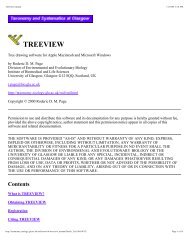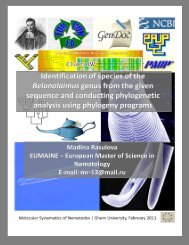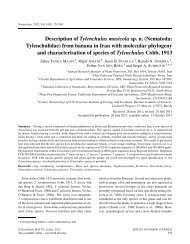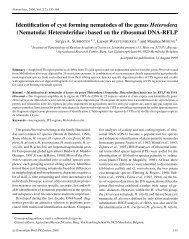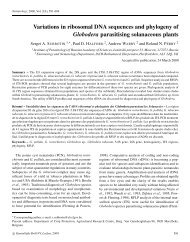Identification of the beet cyst nematode Heterodera schachtii by PCR
Identification of the beet cyst nematode Heterodera schachtii by PCR
Identification of the beet cyst nematode Heterodera schachtii by PCR
Create successful ePaper yourself
Turn your PDF publications into a flip-book with our unique Google optimized e-Paper software.
504<br />
Figure 4. <strong>PCR</strong> on single <strong>cyst</strong>s with species-specific primer<br />
SHF6: L: 100 bp DNA ladder (Promega), 1: Primer combination<br />
SHF6-TW81 and 2: Primer combination SHF6-rDNA2 with same<br />
amount <strong>of</strong> template DNA. 3–11: Duplex <strong>PCR</strong>. 3–6: <strong>Heterodera</strong><br />
<strong>schachtii</strong>;7:H. betae;8:H. trifolii;9:H. glycines; 10: H. ciceri;<br />
11: H. humuli; 12: negative control without DNA. Arrows indicate<br />
specific bands.<br />
Figure 5. Efficiency <strong>of</strong> <strong>PCR</strong> with combinations <strong>of</strong> <strong>the</strong><br />
H. <strong>schachtii</strong> specific-primer and universal primers AB28 (continuous<br />
line) or rDNA2 (dotted line). Curves are produced <strong>by</strong> from<br />
data obtained in three replicates.<br />
constant and not subject to <strong>PCR</strong> conditions. We <strong>the</strong>refore<br />
conclude that <strong>the</strong> RFLP pr<strong>of</strong>iles generated <strong>by</strong><br />
<strong>the</strong>se enzymes are useful for separating H. <strong>schachtii</strong>,<br />
H. betae, H. trifolii and H. medicaginis.<br />
Although Wouts et al. (2001) used ano<strong>the</strong>r set <strong>of</strong><br />
primers to amplify <strong>the</strong> ITS region, our results support<br />
<strong>the</strong>ir data and show that H. betae can easily be<br />
distinguished from H. <strong>schachtii</strong> <strong>by</strong> MvaI. The same<br />
authors did not detect any intraspecific variation in <strong>the</strong><br />
ITS regions <strong>of</strong> four German and Dutch populations <strong>of</strong><br />
H. betae. Our study, however, using populations <strong>of</strong> a<br />
broader geographical origin, allowed concluding for<br />
that on <strong>the</strong> base <strong>of</strong> restriction patterns obtained <strong>by</strong> RsaI.<br />
The RsaI pattern obtained for <strong>the</strong> H. trifolii population<br />
from New Zealand was different from that <strong>of</strong> previously<br />
studied European populations (Subbotin et al., 2000).<br />
As a consequence RsaI cannot be considered as an<br />
appropriate enzyme for species differentiation <strong>of</strong> <strong>the</strong><br />
Schachtii group.<br />
<strong>PCR</strong>-RFLPs are especially suited to identify <strong>cyst</strong>s<br />
or juveniles <strong>of</strong> monospecific populations. However,<br />
this strategy does not allow mixed species populations<br />
to be identified. To overcome this limitation in<br />
<strong>the</strong> H. <strong>schachtii</strong> detection, <strong>PCR</strong> with a species-specific<br />
primer was developed. Unlike standard <strong>PCR</strong>-based<br />
approaches, this technique is based upon allele-specific<br />
amplification, and uses a combination <strong>of</strong> primers in<br />
each <strong>PCR</strong> reaction. The first combination contains a<br />
species-specific primer, which is designed to match<br />
at a species-specific allele. The second contains two<br />
universal primers, which detect DNA <strong>of</strong> all <strong>nematode</strong><br />
species and so indicate if <strong>the</strong> <strong>PCR</strong> has worked well. We<br />
restricted ourselves to <strong>the</strong> design <strong>of</strong> a primer, which,<br />
amplifies in combination with a universal primer only<br />
one haplotype <strong>of</strong> H. <strong>schachtii</strong>. A similar approach<br />
was used for <strong>the</strong> construction <strong>of</strong> a specific primer<br />
for H. glycines (Subbotin et al., 2001a). Our method<br />
detected correctly all H. <strong>schachtii</strong> populations that<br />
were studied, and allow concluding that <strong>the</strong> haplotype<br />
we selected is present in all populations. No positive<br />
reaction was observed with any <strong>of</strong> o<strong>the</strong>r <strong>cyst</strong> forming<br />
<strong>nematode</strong>s species we examined.<br />
The method is <strong>of</strong> important relevance to regulatory<br />
services where information on species identity<br />
is limited. As <strong>the</strong> method is based on <strong>the</strong> detection<br />
<strong>of</strong> a species-specific DNA nucleotide, it can be used<br />
for <strong>the</strong> identification <strong>of</strong> all developmental stages <strong>of</strong><br />
H. <strong>schachtii</strong> at low population density and at any time <strong>of</strong><br />
<strong>the</strong> season. It allows identification in 5 h including DNA<br />
extraction. Detection in mixtures can be improved <strong>by</strong><br />
optimising <strong>the</strong> conditions <strong>of</strong> both <strong>the</strong> DNA extraction<br />
and <strong>the</strong> <strong>PCR</strong>. Fur<strong>the</strong>r tests with more species and<br />
populations <strong>of</strong> <strong>the</strong> H. <strong>schachtii</strong> group and with wider<br />
geographical origins will prove <strong>the</strong> general applicability<br />
<strong>of</strong> our results and confirm <strong>the</strong> robustness <strong>of</strong> <strong>the</strong><br />
method.<br />
The presence <strong>of</strong> H. betae in Morocco is reported<br />
here for <strong>the</strong> first time. The population was isolated<br />
from a heavy soil in Berkane in <strong>the</strong> Moulyia irrigated<br />
area. In this region, from where also <strong>the</strong> first record <strong>of</strong><br />
H. <strong>schachtii</strong> in Morocco was reported (Anon., 1983),<br />
sugar <strong>beet</strong> is rotated every second year with cereals.<br />
Accurate and fast identification <strong>of</strong> <strong>the</strong> yellow <strong>beet</strong> <strong>cyst</strong><br />
<strong>nematode</strong> in o<strong>the</strong>r <strong>beet</strong> growing areas is very important<br />
for planning <strong>of</strong> plant protection measures.



